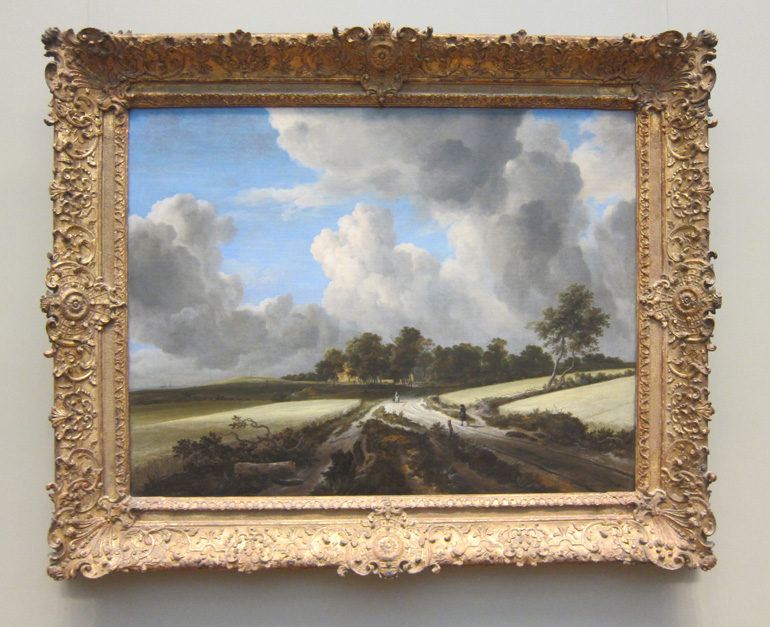Gotham Diary:
Old and New
26 July 2013
It was time to renew our membership at the Museum — the right time. I renew in person because I like to split the cost between two credit cards, and doing so on the 25th of the month ought to result in the charges appearing on successive month’s bills. One in August, one in September.
After a pleasant time at the membership desk — in twenty years, the volunteer told me, she had never split a membership fee between two cards, perhaps her very nice way of wondering if I really belonged at my membership level — I went down to the cafeteria for a burger, fries, and iced tea. (The ice tea is not sweetened.) Somehow, this was not the fun experience that it used to be. The burger was dry and the fries were too thick. Nothing new about any of this. But while I used to think that it was fun to drop into a very stylish high-school cafeteria largely devoid of loutish adolescents, it seems that I don’t anymore. Perhaps I ought to try the salads.
When I was finished with lunch, it occurred to me that I was unaware of the current exhibitions, and had no plans to see anything in particular. I took the elevator up to the second floor, where what I call the Old Master galleries have been completely rearranged. They have also been expanded, taking over what used to be the special-exhibition space at the south end. It will take a while to get used to the new scheme, even though it clearly makes more sense than the old one did. There are lots of unfamiliar pictures, too.
Ruisdael’s Wheat Fields can’t be one of them, but I’m not entirely sure. I’ve been giving Dutch landscapes a pass for years. In fact, I’ve rarely taken close looks at anything but the Vermeers, the ter Borchs, and the de Hoochs. But the rearrangement of the paintings has scattered my prejudices, which are no longer grounded in the floorboards. I even looked at a couple of Rembrandts yesterday. I dislike Rembrandt for the same reason that I love Vermeer: light. Vermeer uses light to make the ordinary extraordinary. Rembrandt uses light to showcase his sitters. Vermeer’s figures, who aren’t sitters, make much more intriguing pictures. Where others see psychological penetration in Rembrandt, I see only the penetration of the masculine ego.
Wheat Fields captivated me yesterday. The light and the clouds are wonderful, of course, but I found myself haunted by the settlement hidden in the trees. Is it a farm? A village? A country seat with a fine view of the sea off to the left? If it were a village, there would probably be a steeple, but you can’t be sure. It’s early summer, perhaps even late spring: the wheat is still short and green. But why doesn’t the tree on the right cast a shadow? A photograph of this scene would not be so engaging, but why?
This is a painting that I look forward to seeing again and again.
***
Never have I seen so many people holding unfolded plans of the Museum’s layout: everyone seemed to be visiting for the first time. When I was young, a year could go by without my setting foot in the Museum, and it was really only after we disencumbered ourselves of a house in the country that I made a point of going to the Museum regularly. It has become a form of exercise for me; I walk around until I’m tired. I try to look at something that I’m not drawn to — another form of exercise. I’m enjoying the changes that the new Campbell regime is making. I actually like most of them, but that’s not as important as the charge that I get from mere change itself, in the vast but familiar building. It makes me feel old in the best possible way: I’m still here! Pasts have died behind me, but I’m still here.
In the piazzas to either side of the main outdoor staircase, in front of the Museum, work is proceeding apace on the new design. The fountain basins have been installed on both sides, and the ground has been prepared for the grove of trees on the north piazza. On the south piazza, they’re still working on that: fitting the irrigation pipes and depositing what looks like gravel granola. The trees will probably be planted in the late fall, when they’re bare. It seems so wrongheaded to put growing things into the cold, dry ground, until you learn how trees work. The subway-station construction at our intersection has of coursed stripped all the trees away, and replaced them with hulking piles of trailers. I miss the trees terribly, and I look forward to the groves at the Museum. Even now, you can tell that the new design is going to be much more appealing than what preceded it, a pair of minimalist, hippodrome-shaped pools, fitted out with low waterspouts that always made me wonder how much they cost to operate (the sign of unsuccessful fountains). Will the new configuration alter the popularity of sitting on the steps?
When clouds like Ruisdael’s are plowing overhead, watching them from the balcony is one of my favorite things to do.

